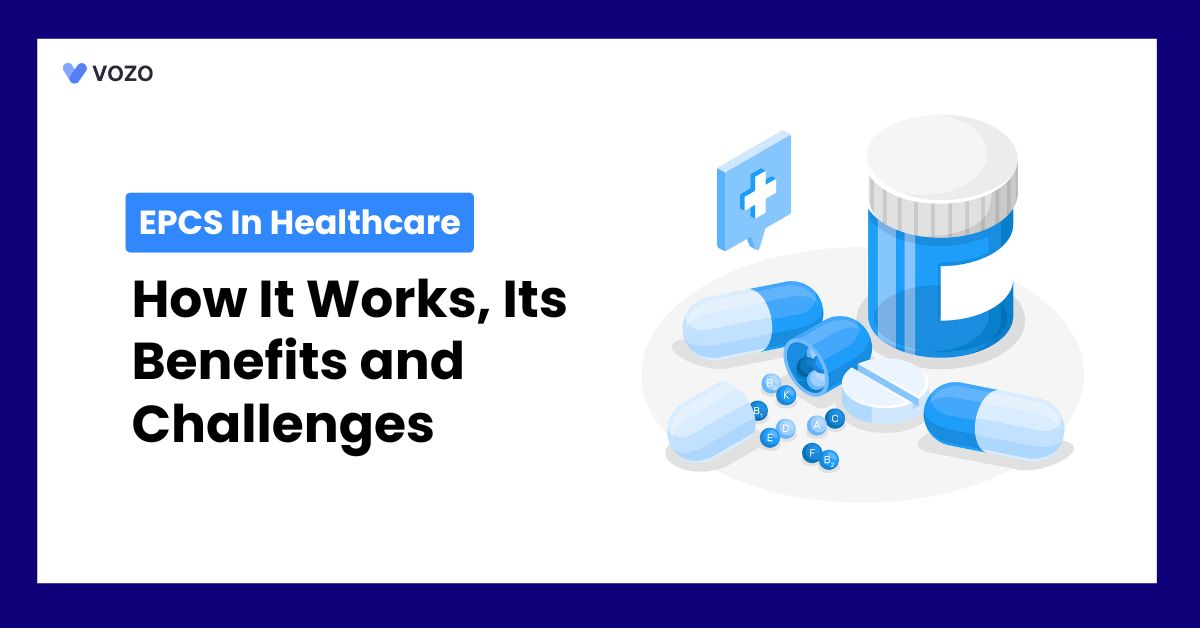EPCS In Healthcare: How It Works, Its Benefits and Challenges
EPCS saw significant growth among prescribers from 2008 to 2021, increasing from 7% to 92%. Previously, the adoption of EPCS was slow, but it began to rise, with almost three-fourths of office-based doctors utilizing it by 2021. This leads to advantages such as greater efficiency, fewer mistakes, and increased patient safety.
In this blog, you will discover EPCS, how it works, its main features, its benefits, and the challenges it faces.
What does EPCS mean?
Electronic Prescribing of Controlled Substances is a secure, digital alternative that replaces paper prescriptions for regulated medications. It enables providers to transmit prescriptions to pharmacy systems electronically, improving workflow efficiency, reducing prescription errors, and preventing forgery.
How EPCS Works: 5 Key Steps in Healthcare
Identity Proofing
The prescriber must verify identity involving a third-party service to confirm their credentials and authorization to prescribe controlled substances.
Certified Software
Prescribers use EPCS-certified EHR or e-prescribing software that meets the Drug Enforcement Administration’s (DEA) requirements and set up 2FA as a token generator from a mobile app.
Prescription Workflow
During a patient visit, the provider enters the medication into the EPCS software and chooses the schedule, such as drug, dosage level, and duration.
Digital Signing with Secure Transmission
The prescriber confirms the details are correct and signs the prescription digitally by completing the authentication. Then, the prescription is transmitted electronically to the pharmacy securely.
Medication Processing
The pharmacy receives the electronic prescription, verifies the DEA details, and dispenses the medicines to the patient.
Related: E-Prescribing 101: What It Is and Why It Matters
Key Features of EPCS in Healthcare
Enhanced Security
The EPCS system uses MFA to verify the provider’s identity to ensure the secure transmission of prescriptions. It encrypts data during transmission to protect information, ensuring HIPAA compliance. EPCS tracks the prescription activities, conducts an audit trail for fraud detection.
Electronic Prescriptions
Prescriptions are transmitted straight from the provider to the pharmacy, decreasing the administrative workload and automating processes like medication refills and prior authorizations.
Drug Interaction Alerts
Alerts notify prescribers of potential drugs and allergies, causing medications ensuring patient safety. It also helps to track a patient’s medication history and identify patterns.
Formulary & Medication Adherence
EPCS allows prescribers to select medications covered by the patient’s insurance, and reminding patients about refills improves cost management.
Better Communication
EPCS facilitates direct communication between healthcare providers and pharmacies, enhances workflow efficiency, and minimizes mistakes. Connecting with EHRs provides access to patient health records, leading to enhanced precision and productivity.
Benefits of an EPCS
Patient Safety
Through EPCS, handwritten prescriptions are eliminated, which causes misreading and reduces the risk of dosage or drug errors. It helps in minimizing drug abuse and forged prescriptions.
Cost-efficient
EPCS reduces the cost of paper, printing, and faxing. The prescription system helps in fast delivery to pharmacies, and time consumption is low.
Regulations
EPCS follows the state and federal laws that support healthcare organizations in audit trails and inspections.
Security Compliance
The system uses encryption for data transmission and authentication. This prevents data theft or cyber attacks.
Patient Convenience
The EPCS system reduces the wait times at pharmacies to get their medicines. Patients need not carry a physical prescription and chances of getting lost.
Related: How to Implement Custom E-Prescription Solutions for Specialty Practices
Challenges of EPCS in Healthcare
Setup Cost
Investment in software, hardware, and identity verification is high. Smaller healthcare organizations may face difficulties financially.
Adoption Issues
This requires proper training for the staff to use and may face resistance from providers to handle tech complexity.
Regulatory Laws
EPCS must comply with DEA and state-level laws, which vary by state and are difficult to implement in multi-state health practices.
Token Generation
Some healthcare providers find difficulty in 2FA, and loss of tokens or devices can delay the prescription process.
Vozo Cloud EHR for your Practice
From managing and organizing patient health records digitally to reducing medical errors, it significantly empowers providers to improve healthcare quality.
If you are searching for the best EHR system for your healthcare practice, Vozo EHR can be your go-to choice.
Our comprehensive EHR solution lets you focus more on patient care while carrying all the burdens and simplifying it.
- Vozo Cloud EHR’s cost-effective cloud subscription benefits all levels of practice.
- Our feature-rich EHR helps you rectify mistakes efficiently and speed up the process.
- Vozo Specialty EHR resonates with specialty practice needs and requirements.
- Our expert technical team has got you covered 24/7 if any needs arise.
- Our EHR System continues to scale as your healthcare practice grows to improve the user experience.
The Vozo Customized EHR solution benefits your healthcare practice by
- Streamlining the administrative process
- Improving workflow efficiency
- Reducing proneness to errors
- Manages all the patient’s records in one place
- Offers greater efficiency and cost-savings across the board.
Our specialty-specific tools like scheduling, patient portals, lab integration, cloud hosting, and more meet the specific needs and requirements of your healthcare practice.
“Embrace Vozo EHR to Reduce Your Burdens and Enhance Patient Care”
About the author

With more than 4 years of experience in the dynamic healthcare technology landscape, Sid specializes in crafting compelling content on topics including EHR/EMR, patient portals, healthcare automation, remote patient monitoring, and health information exchange. His expertise lies in translating cutting-edge innovations and intricate topics into engaging narratives that resonate with diverse audiences.













